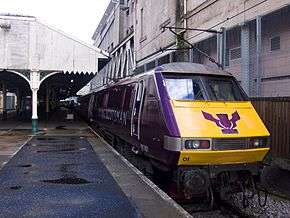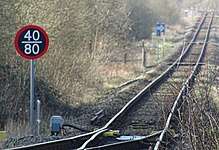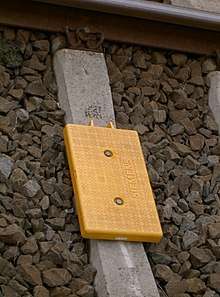Metrication of British transport

A metrication programme for the United Kingdom was announced by the government in 1965 at the behest of the engineering industry and received government approval on condition that its implementation was voluntary, that it was implemented on an industry-by-industry basis and that costs were absorbed where they fell. The metrication of transport related engineering and operational standards, including those used in vehicle design, took place over the following decades, though metrication of certain related sectors had already occurred before this.
Not all of British transport operational standards have been metricated – in the railway industry. Metric units and distances are used on many new systems while most pre-existing systems have retained imperial units, especially for speed and distance. For roads, the engineering of new roads will be to metric standards, but all road signs except those related to vehicle weight limits, use imperial units only, or for those related to vehicle dimension limits may use dual imperial/metric units. Nautical and aviation operational practice is to retain the use of the knot for speed, the nautical mile for distance and, in the case of aviation, the foot for altitude.
Background
Historically, British industry opposed metrication on the ground that most of British exports went to countries that used the imperial or US customary systems of units. By the 1960s, changing trade patterns meant that this was no longer the case, and in 1965 the Federation of British Industry (now the Confederation of British Industry) initiated a change to the metric system.[2] The government agreed on condition that the changeover was voluntary on a sector-by-sector basis, that costs would be absorbed where they fell and that there would be minimal legislation.[3] In some cases it was appropriate to use hard metrication and in other cases soft metrication – soft metrication being defined as "the conversion of ... non-SI measurements to equivalent SI units, within the established measurement tolerances. In general, 'soft metric' products will not differ physically from analogous [non-SI] products.[4]
Until 1969, when the Metrication Board was set up, the Royal Society and the British Standards Institution took the lead. When the Metrication Board was set up, much of the groundwork had been done, and metrication of many engineering sectors, including transport, was under way. From the early to mid-1970s, the lack of compulsion slowed the process of metrication, so a draft order was prepared to complete the process. The Government, which had a very small majority, chose not to proceed with the order.[5]
When Britain joined the European Economic Community in 1973, it was obliged to adapt local law to accommodate EEC directives that were in place.[6] One of these directives, 71/354/EEC, required a harmonisation of units of measure "for economic, public health, public safety or administrative purposes". By the late 1970s the British metrication programme had run out of steam and, at Britain's request, Directive 71/354/EEC was superseded by Directive 80/181/EEC, which among other things permitted the use of miles, yards, feet, inches and fathoms in the United Kingdom, and knots until 1989 (subsequently extended to 1994). As from 1 January 1990, the use of miles, yards, feet and inches was restricted to "Road traffic signs, distance and speed measurement[s]" only. The directive did not apply to areas of transport that were subject to governmental international agreements.
Road transport
Motor fuel has been retailed in litres in the UK since the 1980s and fuel consumption is still commonly quoted in miles per gallon.[7][8]
Rail transport


The main push towards using the metric system took place during the early 1970s.[10]
Railway operations
Changes in operational procedures have not always been synchronised with changes in technology – for example, in 2010 it was reported that drivers of freight trains operating on single track in the West Highlands had to report the lengths of their trains verbally to the signalling staff using feet even though the computer generated information available to the driver was in metres.[11]
Pan-European signalling systems


The European Rail Traffic Management System (ERTMS) is an initiative backed by the European Union to enhance cross-border interoperability and the procurement of signalling equipment by creating a single Europe-wide standard for train control and command systems. Its main components are European Train Control System (ETCS) and GSM-R communications system.[13] ETCS is a standard for track-train radio communications using balises (Eurobalises) and associated in-cab train control[14] while GSM-R is the GSM mobile communications standard for railway operations. ERTMS can operate at different levels depending on specific local requirements.[15][16][Note 1] Under ERTMS speeds are displayed in the driver's cab in km/h and at Level 2, lineside speed indicators are optional.[17]
In 2007 the British Government published its response to a European Union directive[18][19] requiring the use of ERTMS on High Speed (TEN-R)and Conventional Trans-European Railway Network (TEN) routes. The response proposed a roll-out plan of ERTMS equipment on existing lines that would be completed by 2044 though the actual timing of the programme will depend on changing circumstances – new trains will be ordered with ERTMS equipment on board and ERTMS would be installed during any electrification programs.[20] In 2009, the Rail Safety and Standards Board confirmed that km/h would be used on ERTMS lines in the United Kingdom.[21] With the ongoing introduction of ERTMS, it is foreseen that the metrication of British rail transport will be completed over the next few decades.[22]
The Uff/Cullen inquiry (2001) following the Southall and Ladbroke Grove rail crashes identified a need for in-cab signalling on high-speed trains and recommended that ERTMS should be installed onto all of Britain's high-speed lines by the year 2010. This timescale was judged not to be viable because of the time required to develop the technology.[23]
A standard feature of the speedometers used by ERTMS/ETCS systems is the use of the metric system.[24] At a Railway Conference in 2002, it was argued that a changeover to using metric units for speed in advance of the introduction of ERTMS was unlikely to be financially viable unless the decision is taken to adopt Level 2 ERTMS without lineside signalling. The need to handle both mph and km/h would continue though.[17] A 2010 voluntary standards document published by the Rail Safety and Standards Board addressed this issue when it recommended that the speedometer of a ETCS system be designed so that it switches automatically between mph and km/h depending on the route being traversed. The speedometer would display "mph" when the speedometer was displaying "miles per hour", otherwise would display nothing. Its graduations would be chosen such that the angle of the needle would not change when the system switched from one scale to the other. The conversion between metric and imperial units would be a function of the speedometer, not of any other on-board equipment.[25] In 2012 a technical specification matching this proposal was published.[26]
The Cambrian Line, a low volume 215 km (134 mi) rail link between Shrewsbury in the east and Aberystwyth and Pwllheli in the west, was chosen as Britain's first ERTMS line. This line was chosen as its signalling system had reached the end of its useful life, and because it is a low capacity line almost separate from the national network, making it an ideal site on which to gain ERTMS experience.[20][27] All speeds in the Cambrian Line Rule book are in km/h."[12][28] ERTMS will be rolled out on the Great Western Route as part of the electrification and resignalling work[29] which is expected[Note 2] to reach Oxford and Newbury by 2016 and Cardiff by 2017.[30] Other early mainline conversions to the ERTMS standards are expected to include[20] the 251 km (156 mi) London (Kings Cross) to Doncaster route by 2020 and the 158 km (98 mi) London (St Pancras) to Leicester route by 2022[31][32] while the specification for the proposed High Speed 2 (HS2) link from London to Manchester, Leeds and beyond assumes a minimum of Level 2 ERTMS control and signalling for the "day one service".[33] The Crossrail project in London will also implement ERTMS technology.[34]
Water transport
Units of measure related to British water transport can be divided into several categories including: those related to navigation, those related to transport operation, those related to the engineering of waterways and those related the engineering of the vessels. Many of these units of measure used are dictated by industrial standards and international conventions rather than by United Kingdom and EU legislation;[Note 3] with UK law itself appearing not only in Acts of Parliament and Statutory Instruments but also in Merchant Shipping Notices (MSNs) containing the technical details of Statutory Instruments.[35]
Notes
- ↑
Three levels have been identified for ERTMS:
- Level 1 – ERTMS is added to or overlaid on lineside signals and train detectors. Communication is via balises (Eurobalises) of an existing railway system.
- Level 2 – ERTMS uses balises to communicate with the driver, thereby dispensing with lineside signalling equipment. The location of each block is fixed (as with traditional railway systems).
- Level 3 – Level 3 is an enhancement on Level 2 whereby the block will move with the train.
- ↑ As of 2012, the rebuilding of bridges to accommodate the overhead wires was in progress
- ↑ EU directive 80/181/EEC specifically excludes cases that "have been laid down in international conventions or agreements binding the Community or the Member States"
References
- ↑ Barnett, Roger (June 1992). British Rail's InterCity 125 and 225 (PDF) (Report). Berkeley, California: The University of California Transportation Center. p. 34. UCTC No. 114. Archived from the original (PDF) on 29 May 2008. Retrieved 19 October 2011.
- ↑ "White Paper on Metrication (1972) – Summary and Conclusions – §42" (PDF). London: Department of Trade and Industry Consumer and Competition Policy Directorate. Archived from the original (PDF) on 2005-03-04.
- ↑ Hemenway, David (April 1979). "Standards systems in Canada, the UK, West Germany and Denmark: An overview" (PDF). Washington DC: National Bureau of Standards.
- ↑ "Metric Usage". Resources for Employees and Guests. Lawrence Berkeley National Laboratory. Retrieved 13 July 2012.
- ↑ "Historical Perspectives on Metrication by Jim Humble who was the last Director of the UK Metrication Board". Retrieved 23 March 2012.
- ↑ "European Documentation Centre – European Union legislation". Library Services. University of Hull. 30 September 2011. Missing or empty
|url=(help);|access-date=requires|url=(help) - ↑ "30 anniversary 1979 – 2009" (PDF). United Kingdom Petroleum Industry Association Limited. 2009. Retrieved 13 July 2012.
- ↑ Millward, David (2 August 2008). "UK drivers say no to metric road signs". The Daily Telegraph. London. Retrieved 30 June 2012.
- ↑ "Master Rulebook: Signals, hand signals, indicators and signs handbook. Section 7.4 "Differential permissible speed indicators"" (pdf). Network Rail. Retrieved 2018-10-14.
- ↑ "Final Report of the Metrication Board (1980)" (PDF). London: Department of Trade and Industry Consumer and Competition Policy Directorate. para 2.20/21. Archived from the original (PDF) on 2005-03-04.
- ↑ "40565 Metric system not applied in the West Highlands region". CIRAS, the rail industry's confidential reporting system. March 2010. Retrieved 29 July 2012.
- 1 2 "Incident at Llanbadarn Automatic Barrier Crossing (Locally Monitored), near Aberystwyth, 19 June 2011" (PDF). Accident Rail Report. Rail Accident Investigations Branch. June 2012. Figure 5 shows a 65 km/h speed restriction; Figure 10 shows a speedometer displaying 39 km/h with a 98 km/h hook. Retrieved 28 July 2012.
- ↑ 'ERTMS in 10 questions,' "Archived copy" (PDF). Archived from the original (PDF) on 15 February 2010. Retrieved 2016-02-27.
- ↑ "Trainguard – Full interoperability for European railways" (PDF). Brunswick, Germany: Siemens AG. 2006. Retrieved 28 July 2012.
- ↑ Davies, David (February 2000). "Automatic Train Protection for the Railway Network in Britain – A Study" (PDF). Royal Academy of Engineering: 73–74. ISBN 1871634881. Retrieved 31 July 2012.
- ↑ "ERTMS Levels – Different ERTMS/ETCS Application Levels to match Customers' needs" (PDF). UNIFE (formerly Union des Industries Ferroviaires Européennes – the Association of the European Rail Industry). 2012. Retrieved 22 July 2012.
- 1 2 Porter, Derek (2002). Implementing ERTMS in the UK: Human Factor Implication for Train Drivers. International Railway Safety Conference. Retrieved 24 July 2012.
It is unlikely to be financially viable to change all UK lineside signs to Kph(sic) unless the decision is taken to adopt Level 2 ERTMS without lineside signalling.
- ↑ "EC sets out ERTMS deployment deadlines". Railway Gazette International. 31 July 2009. Retrieved 22 July 2012.
- ↑ Ilie, Elena (22 March 2012). "ETCS, an intermodality harmonization plus". Bucharest: Railway PRO. Retrieved 28 July 2012.
- 1 2 3 "ERTMS National Implementation Plan" (PDF). Department for Transport. September 2007. Archived from the original (PDF) on 2011-10-05. Retrieved 23 July 2012.
- ↑ "GE/RT8000/AM – ERTMS Rule Book – ERTMS Amendments module" (PDF) (1). Rail Safety and Standards Board. October 2009: 4, 5. Retrieved 30 July 2012.
- ↑ "End of the line for the mile, the chain and the yard". Railnews. 1 October 2013. Retrieved 5 October 2013.
- ↑ "European Rail Traffic Management System (ERTMS)". Office of Rail Regulation. 18 February 2008. Retrieved 23 July 2012.
- ↑ Barrow, Alan (1 December 2007). "ABA Surveying Ltd – Getting the ERTMS project off to a flying start". Venture online – The Magazine for Business Management. Archived from the original on 5 May 2013. Retrieved 19 February 2013.
ABA have installed a system of permanent ground markers in pairs at nominal ten kilometre spacing
- ↑ "Rail Industry Standard for Onboard ETCS" (PDF). 1. Rail Safety and Standards Board Ltd. 4 September 2010. Retrieved 28 July 2012.
- ↑ "Guidance on ERTMS/ETCS DMI National Requirements" (PDF). Rail Safety and Standards Board. March 2012. Para 2.1.1. Retrieved 23 July 2012.
- ↑ Silvester, Katie (August 2011). "Display mode". Rail Professional. Archived from the original on 2013-04-21. Retrieved 25 July 2012.
- ↑ "Rule Book Briefing Leaflet – ERTMS Modules" (PDF). Rail Safety and Standards Board. June 2010. Archived from the original (PDF) on 10 June 2015. Retrieved 23 July 2012.
- ↑ "European Rail Traffic Management System (ERTMS)". Network Rail. Spring 2012. Retrieved 30 July 2012.
- ↑ "Delivering the plans". Network Rail. Spring 2012. Retrieved 30 July 2012.
- ↑ "East Coast Main Line (ECML), Edinburgh to London, United Kingdom". railway-technology.com (Net Resources International). 2011. Retrieved 24 July 2012.
- ↑ "ERTMS Deployment in the UK – Re-signalling as a key measure to enhance rail operations" (PDF). UNIFE (formerly Union des Industries Ferroviaires Européennes – the Association of the European Rail Industry). 2012. Retrieved 23 July 2012.
- ↑ "HS2 Project Specification". HS2 Ltd. (owned by Department for Transport). January 2012. Para 4.4.
- ↑ "Crossrail, London, United Kingdom". Retrieved 2014-07-19.
- ↑ "Merchant shipping notices (MSNs)". Maritime and Coastguard Agency. 2014. Retrieved 30 July 2014.

